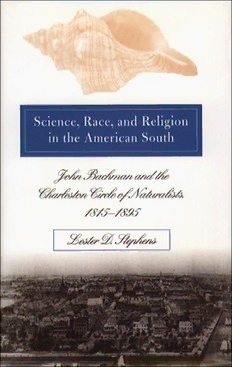
Science, Race, and Religion in the American South: John Bachman and the Charleston Circle of Naturalists, 1815-1895 PDF
Preview Science, Race, and Religion in the American South: John Bachman and the Charleston Circle of Naturalists, 1815-1895
Science, Race, and Religion in the American South lester d. stephens . . . . . . . . . . . . . . . . . . . . . . . . . . . . . . . . Science, Race, and Religion in the American South john bachman and the charleston circle of naturalists, 1815–1895 The University of North Carolina Press Chapel Hill & London ∫ 2000 The University of North Carolina Press All rights reserved Manufactured in the United States of America This book was set in Monotype Bulmer by Keystone Typesetting, Inc. Book design by April Leidig-Higgins The paper in this book meets the guidelines for permanence and durability of the Committee on Production Guidelines for Book Longevity of the Council on Library Resources. Frontispiece: ‘‘Charleston, 1851: View from the Ashley River at White Point Gardens,’’ by William Hill. Photograph courtesy of the South Carolina Historical Society. Library of Congress Cataloging-in-Publication Data Stephens, Lester D. Science, race, and religion in the American South: John Bachman and the Charleston circle of naturalists, 1815–1895 / by Lester D. Stephens p. cm. Includes bibliographical references and index. isbn 0-8078-2518-2 (cloth: alk. paper) 1. Naturalists—South Carolina—Charleston Biography. 2. Natural history—South Carolina—Charleston—History— 19th century. 3. Bachman, John, 1790–1874. I. Title. qh26.s735 2000 508%.092%2757915—dc21 99-27008 cip 04 03 02 01 00 5 4 3 2 1 contents . . . . . . . . . . . . . . . . . . . . . . . Preface ix Acknowledgments xv Scientific Terms Used in This Work xvii 1 In a Singular Place 1 2 Exalting Two Books 11 3 In the Shadow of Audubon 39 4 Treasures of Earth and Sea 60 5 A Low Class of Animals 78 6 From Alpha to Omega 101 7 Ancient Animals 127 8 Passionate Pursuits 146 9 Hyenas and Hybrids 165 10 The Jawbone of an Ass 195 11 The Broken Circle 218 12 Last Links 239 Epilogue 264 Notes 269 Bibliography 303 Index 327 illustrations . . . . . . . . . . . . . . . . . . . . . Charleston, 1851 Frontispiece John Bachman 23 Four species of shrews 29 John James Audubon 40 Edmund Ravenel 68 Fossil echinoderms 72 John Edwards Holbrook 86 Blanding’s turtle 93 Lewis Reeve Gibbes 111 Dwarf waterdog 118 Francis Simmons Holmes 129 Fossil gastropod shells 137 John McCrady 151 Two species of hydromedusae 154 Samuel George Morton 169 Louis Agassiz 175 Josiah Clark Nott 206 preface . . . . . . . . . . . . . . . . . . . . . . . . By the 1840s the city of Charleston, South Carolina, was gaining notice as an important center of natural history research in the Old South, and by the early 1850s no other city in the region matched it in the number and quality of scientific contributions. In addition, by midcentury no southern city could boast of a natural history museum that paralleled the one in Charleston, nor did any equal the productiv- ity of its scientific society. The only regional rival to Charleston was the much larger city of New Orleans, which nourished the interests of an able group of naturalists and its active scientific society and encour- aged the development of natural history collections. While their e√orts are notable, however, the naturalists of New Orleans produced fewer scientific works than their Charleston counterparts, and they enjoyed less success than their sister-city compatriots in promoting a strong museum and in advancing the status of their scientific organization. That Charleston had attained status as the center of natural history research in the South is also evident from the volume and nature of the Charleston scientists’ correspondence with leading American and Eu- ropean naturalists and from the expressions of interest shown by the great Swiss naturalist Louis Agassiz, who visited the city in 1847, soon after his arrival in the United States, and again every year between 1849 and 1853. Agassiz’s repeated praise of the Charleston naturalists and the Charleston Museum and his assistance in getting the American Association for the Advancement of Science to hold its third meeting in Charleston, in 1850, indicate the national standing of the city in natural history research. At that time, only three other cities in the United States—Philadel- phia, Boston, and New York—exceeded Charleston in natural history studies. The standing of Charleston in the field is all the more notable when one compares its size to that of the northeastern cities, each of which was many times larger in population. Moreover, each of the
